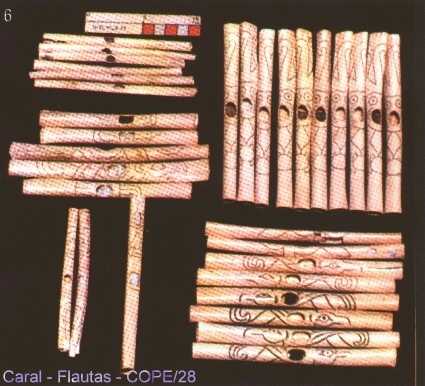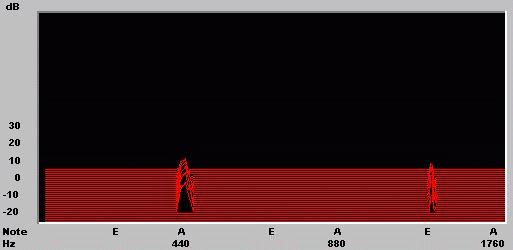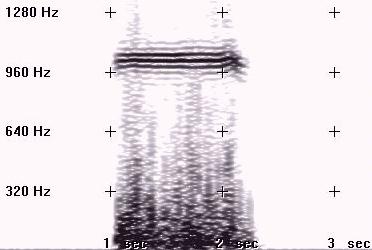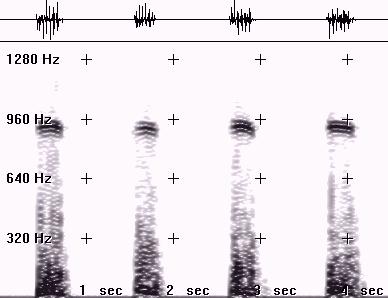
Español
Caral´s aerophones
The oldest playable tubes with a side hole and a stick inside
Roberto Velázquez Cabrera
First draft: February 19, 2002. Last version: March 18, 2002.

Photo from Punto y Línea, Arte Peruano (14) and first published by COPE from Petroperu (15), in Vol. XI-No 28, September 2001.
The bone tubes are in the Museo de Arqueología y Antropología de la Universidad Nacional Mayor de San Marcos, Lima, Perú.
The reference
The main reference for this work is an extraordinry article in Spanish (1) by the archaeologist Dr. Ruth
Shady Solis director of the Museo de Arqueología y Antropología de la Universidad Nacional Mayor de San Marcos,
and several researchers including three acousticians, published in
November 2000. It was found in Internet and it includes analysis and data from
archaeology, organology and acoustics. It is extraordinary because in the network there are very few open formal papers
about old aerophones with data to make replicas. From the rich Peruvian organology were found only other
two unusual studies about important sets of relevant aerophones: one is about the Whistling Vessels (2) and other is related
to the Antaras Nasquenses (3), which also include acoustical analysis and
data. To date, little attention has been directed at understanding thousands
of sonorous artifacts that were discovered from great ancient cultures even though
traditional western musical instruments have been subjected to intensive
scientific analysis.
The discovery
In mid 1999 (4), thirty-two pelican (Pelican thagus) or condor bones tubes were
found in the archaeological site of Caral-Supe located in a river valley at 182 km
north Lima and at 23 km from Pacific Ocean Cost. Caral may be the oldest
sacred city of America (~2,000-2,600 B.C.). Caral had al least six big pyramids up to 30 m high and a extension of 50 Ha.
A pretty image of Caral sacred city is in a page of World Monuments Fund (WMF).
The set of wind artifacts was located in
the
south-west or left (in the photo) corner in the exterior of the circular plaza. This is a photo of the Anphitheater provided by WMF with © R. Shady/WMF.
The bone tubes were covered by
sand over a cuted stone, in a space delimited by cuted stones, rolled stones and
a
human figure without face made of clay. The sonic artifacts were located in a
stratigraphyc order, in relation to the carved figures in their surface: first,
they
found the artifacts decorated with monkeys and antromorphous faces; then, the
tubes with birds and; finally, those with out decorations. Some bones have four
signs of tying from ropes or cords, near the extremes and the center.
It is interesting to see that in 10 the mouth or sound hole is also the mouth of the figure
carved on their surface, which clearly indicates that it is for singing.
The organological design is an open tube with an oval sound hole or mouth near the
center,
but with a brick or a piece of hard clay placed face to face of it and inside
the tube
(Figure 1). In few small tubes the mouth is rectangular. The old tubes have irregular cross section and shape because they
were made with bones from pelican or condor.

Fig. 1. Drawing of the longitudinal cutting.
Fifteen bone tubes were found complete.
This table in small .jpg format or
in bigger format, obtained from the reference (1) shows the data and main sizes of the analyzed tubes:
number, length, inside diameter of left and right holes, distance from the piece
of clay to the left and to the right extremes and the central hole diameter.
The averaged weights of the bricks are 0.15-0.54 gr. with triangular shapes and
rounded sides and some of them were lost during their exploration and cleaning.
Findings from the reference (1)
The aerophones were classified as tubular horizontal flutes or traverse flutes,
considering the way of making the artifacts, more that the way o playing them,
which is unknown. It was found the F0 (fundamental/musical note) for the four basic
operations with the two extremes closed, opened, closed/opened and
opened/closed. Spectrums were obtained of the flutes sounds with a secondary
peak at one side of the 1st and 2nd harmonics and in some cases there are
harmonics of superior order. Increasing the airflow velocity it was possible to
pass
from the 1st harmonic to the 2nd, as it is well know in modern flutes. Also,
a PVC replica was used to test the previous findings and to analyze the
functioning of the tubes using measurement for the sonorous pressure
distribution
inside the replica with a prove microphone and spectrums. The two semitubes act as coupled tubes, by the effect of the piece of clay, with two
peaks in the frequency domain and an audible modulation in the time domain,
operated in several modes and obtained with a spectrum analyzer with two input
signals.
Other preliminary findings
It is impossible to know the exact ancient way of playing many aerophones, like
those from Caral and it is difficult to obtain exact results with out the direct
analysis of the ancient wind artifacts. In this case the shape and surface o the
resonating tube and the piece of clay are not clear in the open pictures and
drawings. It is necessary to have more information and data about the size,
geometry and surface of the internal resonator tube, the thickness of the wall
and
the piece of clay, because small variations in the dimensions of the brick can
produce big changes in the sounds and even the silence.
However, it was possible to use a simple method applied in previous studies (5).
Applying carefully observation with the help of experimental replicas in several
materials like “carrizo” (a mexican cane), bamboo, wood and clay (the brick was made with fired clay powder and glue)
and some computer programs (6 &7) to obtain spectrograms (to see the signal variations in
the time), it was possible to get other preliminary findings about their sonic
features and possible uses.
Finding 1. The main distinction of this set of aerophones is precisely that it
is a
SET or a group of very similar tubes in material and structure. The second is
that it
seems that 21 tubes have also very similar size (~ 16 -17 cm L). It means that
they
belong to a homogeneous family of aerophones, from the point of view of
organology, and they could be played in groups with special effects.
Finding 2. There are other older playable bones flutes (8) like those found in
Jihau, China (~7,000 B.C.), but the embouchure or blowing mechanism design
from Caral may be the oldest oval side sound hole, which was unchanged in more
than 4,600 years. It is an antique American root of the modern flute
embouchure.
Finding 3. This organologic design was found in several great cultures from
Ancient America. Several similar tubular and globular aerophones were found in
the Ancient Mexico zone. A good example is a clay whistle from Yaxchilán,
Chiapas (this is the clay model with a longitudinal cutting) that is included in a study in development (9). Also, there are several
clay
tubular traverse whistles in several Mexican cultures, like this made by Mario Cortés(18) . This relevant relation
means
that the people from Ancient America had very similar sonic culture and
technology and they were better communicated than the actual inhabitants from
the same zone.
Finding 4. The bone tubes without the piece of clay inside can be played easy,
very well, soft and loud, in several ways like other antique aerophones:
horizontally, exited by the two sides and; vertically, exited by the two
extremes,
opened and closed and in different angles, from the way to play the Quena to the
Pan flute (like the Peruvian Siringa, Zampoña or Antara). The sonorous design is
simple but it can be a multifunctional tubular wind artifact or
aerophone.
Finding 5. Twenty-one bone tubes are similar in size to the tubes I use as
diapason to tune vertical flutes. The biggest tube (16.6 cm L) can produce a F0
or note ~ 440 Hz and higher sounds, played vertically (like Quena) and closing the distal and
central holes. Figure 2 shows the A4 notes in 3D. This finding means that it may
be the first diapason in the world.

Fig. 2. A4 note (~440 Hz)
Finding 6. Modern flutes with similar embouchure are designed to produce a flat
response, with a wide set of musical notes, few octaves and very small variation
in
pitch, loudness and timber in a narrow range of less that a semitone (10). The
replicas with the old sounding mechanism can produce few musical notes, but a
wide range of continuos F0, only changing the angle and velocity of the blowing
and the distance of the mouth or the gap. Not only it is possible to jump to the
next
octave, but to move inside the same octave under a wide range. Figure 3 shows
the strong signal obtained playing the tube horizontally and closed, a range
~700-
900 Hz. It means that the old design can play microtonalities in a wide range; witch
is
also a common feature of many antique aerophones with that kind of embouchure,
like some from Ancient Mexico analyzed before. Old whistles, even with out pitch
holes, can be tuned during their operation in a range of pitch to produce
beautiful
sounds with continuos change in pitch and the loudness like those from the birds carved on the bone tubes.

Fig. 3. Microtonalities
Finding 7. It is very difficult to know the exact old way of playing these tubes
as
musical instruments. The tubes can play melodic music with few notes, but very
beautiful in timber and microtonalities and they can be used to play rhythms.
The
flutes are melodic instruments and people from cold climates like melodies, more
than rhythms, which are preferred in communities from warm climates. It seems
that ancient Caral climate was much warmer (350 m above sea level) than those
from high mountains where many flutes sounds are listened.
However, in Peru the situation is very special, because their organology is very rich.
Other ancient instrument were found
in several cultures, places, altitudes and climates. Even now, their flutes are played almost everywhere.
Finding 8. The higher sounds of all the aerophones can be loud and be heard at a
considerable distance, because their pitch is located in the range of maximum
sensitivity of humans. The smaller replicas can easily generate F0 near ~2 kHz
with higher harmonics. It means that they could be heard very well in the
circular
plaza and in any closed or open space of the sacred city. This may be one of the
reasons of its selected size and it may be an insight of the possible old
use.
Finding 9. The special acoustical effects could be more if the archaeological
site
was designed for that end as it happen in other ceremonial old spaces. Celso
Llimpe Quintanilla, one of the Peruvian acousticians commented that some spaces
of Caral favor the acoustics and produce the reverberation of sounds.
Finding 10. It had been seen that the most special effects of some old whistles
could be produced if they are played in groups at the same time (11). The old
tubes played in groups can produce binaural beats (phantom sounds) due to the
differences in their sizes. And some of them can produce infrasonic binaural
beats
because the difference in size in small in most of them. The effect is inside
the
head, originated in the brainstem within the contralateral audio-processing
regions
called the superior olivary nuclei. This auditory sensation is neurologically
routed
to the reticular formation and simultaneously volume conducted to the cortex
where it can be objectively measured as a frequency-following response
(12).
Finding 11. The tubes with the brick inside can produce several very special
sounds and effects. Played horizontally, one observed effect is a noisy reedy sound.
Played vertically, some special sounds can be obtained operating the aerophone like a
whistle or organ tube with the central hole opened and the distal hole closed.
If the
input airflow is complex the output signal is more complex. Figure 4 shows the
spectrogram in 2D of a signal with three strong peaks and wide bandwidth pink noise
in the low frequencies, obtained vibrating the tongue during the operation, a
common old way of playing aerophones. The last findings can support new
hypothesis for research. It have been reported that binaural beats plus pink
sound
can produce special states of conscience and effects in the physical and mental
health of human listeners in the near field or closed spaces (12 &13). There are
patented modern sound healing therapies and remedies, but it is relevant to find
that very old masters on sonic generators could know and used similar
techniques.

Fig. 4. A complex sound
Finding 12. If the input airflow has variations or is intermittent, the generated
sounds
can be very similar to those produce by several biological beings that existed
and
were sacred in old times. Figure 5 shows the signal that appears a croak or roar
sound from a frog. Then, a set of those tubes may imitate frogs chorus. This may
be an ancient sonic use of the bone tubes because the Caral valley has the Supe
River and had irrigation channels, vegetation and marshes during the rain
season,
an ideal environment to proliferate the amphibious life and they may had
ceremonies or rites with frogs chorus to call the rain, like other ancient
farmers (9).

Fig. 5. A frog's sound
Finding 13. It is not known if the antique sonorous artifacts were made
in Caral, but by their great similitude in material, structure and manufacture techniques
it is possible that they were made by an artisan or an artisan community with an own oganological
style. If the ancient habitants of Caral had a special taste or intensive ceremonial or rituals
uses of sonic artifacts, which it may be, it is possible that there are other artifacts buried in that site.
Conclusion. The paper shows that the tubes have several special
acoustical properties and possible ancient uses. But the findings may be
confirmed and other features may be found if they are analyzed
with calibrated equipment, advanced techniques under controlled conditions,
complemented with deeper archaeological data. And there are other unanswered questions.
For example, if the tubes can produce monkeys sounds and if they could be used in other kind
of ceremonies or rites.
Other experiments
Conclusion 14. The experimental models, operated as transverse flutes can produce sound pressures of 88 dB - 90 dB (at 1 m and 0 degrees), which is equal to a radiated acoustic power of ~ 0.008-0.01 Watts. That power transmits the sounds at a considerable distance.
In a study on the Tubular gamitadera with membrane some Carals's models were used to see the acoustical effect of a membrane affixed in one extreme. The gamitadera was used in several zones of America to call deers and other animals, imitating their sounds.

gamitaderas with a lateral hole, made of bamboo and y Carrizo (a mexican cane)
The membrane on the bamboo is made of thin plastic affixed with a nylon cord. The membrane on the Carrizo is made of cellophane affixed with a rubber band. The thin membrane and the cord can be made of other thin materials. This kind of gamitadera is not excited with a blowing. Introducing vibrations generated with the vocal cords, the strongest effects are produced. It can also be operated as a trumpet, exciting the tube and membrane with vibrations from the lips and changing the configuration of the vocal tract, sound modulations can be produced.
Conclusion 15. The model works fine with and with out the internal brick and can generate several sounds, as the following :

Spectrogram of a simple sound of the bamboo tube with membrane and brick-less.
The sound is similar to a buzzing or reedy, but its F0 shows microtonal variations with many harmonics.
Conclusion 16. The tube also works fine to imitate animal sounds and to produce other complex signals.

Spectrogram of a complex sound.
That complex sound is not musical, because it has a lot of noise and it seems a roaring of a feline, a monkey or other unknown animal.
Conclusion 17. The acoustic power of tubes played as gamitadera is equal when is played as a transverse flute. Due to the harmonics, it can also be heard at considerable distance.
Conclusion 18. It is difficult to know if the Caral's tubes were use with membranes, because their natural material was perishable (bat's wings, spider’s webs, etc.), but this hypothesis was analyzed due to that some of them have incisions near their extremes on the surface of the wall, and in the photos shows some carved figures of monkeys. The result of the exercises show that the aerophone's design is more multifunctional, as it was though hen the first experiments were done, and some of their sound are very similar to those of monkeys.
Notes.
1. The authors of the main reference (1) were invited to present their results
in the First Special Session on Ancient Musical Artifacts (16) to be included in the International Joint Meeting
of Acousticians ASA-FIA-IMA, Cancun, Mexico, December 2-6, 2002.
2. I wish to thank Sonia/Punto y Línea-Arte peruano and K. Porteous/WMF because they supported to get
the digital images from the flutes and Caral.
3. Caral and Yaxchilán are in the list of the 100 Most Endangered Sites in 2002 from the WMF (17).
References.
1.http://www.ia.csic.es/sea/publicaciones/4375ef002.pdf
2.http://www.statnekov.com/
3.http://www.maa.uw.edu.pl/espanol/proyecto_antaras_nasquenses.htm
4.http://museoarqueologiasanmarcos.perucultural.org.pe/caral.htm
5.http://www.geocities.com/rvelaz.geo/english.html
6.http://www.zeta.org.au/~dvolkmer/tuneit.html
7.http://www.visualizationsoftware.com/gram.html
8.http://www.geocities.com/rvelaz.geo/china/china.html
9.Velázquez-Cabrera, Roberto. “Yaxchilán´s whistles”. Study in development
10.Coltman, John. “Resonance and Sounding Frequencies of the Flute”. JASA
99-107 (1966)
11. http://www.newfrontier.com/1/peru795.htm
12.http://www.monroeinstitute.org/research/
13.http://www.appliedmusic.com/psycho.html
14.http://mx.groups.yahoo.com/group/arteperuano/files/puntoylinea/Caral/
15.http://www.petroperu.com/
16.http://www.geocities.com/sberista/art.html
17.http://wmf.org/a/watchlist.htm
18.http://www.geocities.com/mctlapitzali









